The compressor pulley is mounted on a double-row ball bearing.
When pressing out, the bearing is destroyed, so we press it out only for replacement
We bleed the refrigerant from the air conditioning system and remove the compressor, as described in the article - How to remove the air conditioning compressor of the Lada Largus car

Holding the compressor rotor from turning with a special device

Device for fixing the compressor rotor
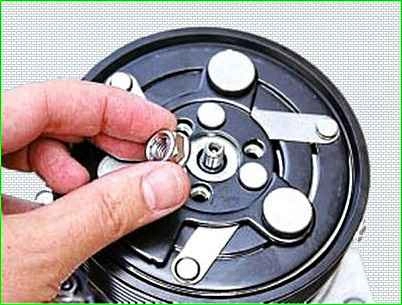
Unscrew the nut fastening the pressure plate
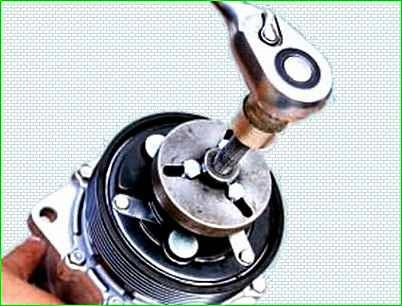
Using a puller, press the pressure plate off the compressor shaft
If the pressure plate is tight and rusted to the splines of the shaft, do not try to remove it by inserting a screwdriver into the gap between the pulley and the plate. This will cause deformation of the plate.
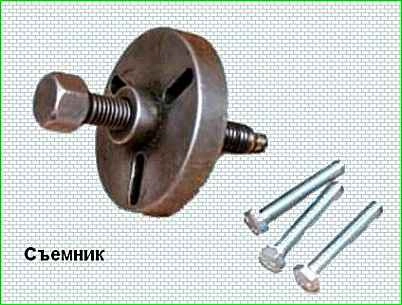
To remove the pressure plate, use a special puller
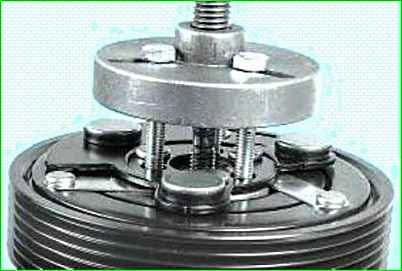
Screw the puller bolts into the threaded holes of the pressure plate and rotate the stop screw of the puller

Press off the plate
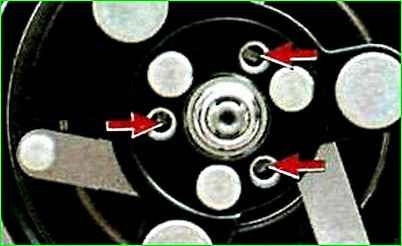
Some plates do not have threads in the holes. Then you need to cut the M6 thread

Inspecting the working surfaces of the pulley
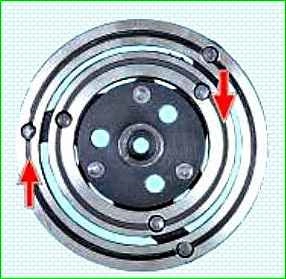
We inspect the working surfaces of the plate for deep scratches, burrs, and signs of wear and overheating. If necessary, replace parts
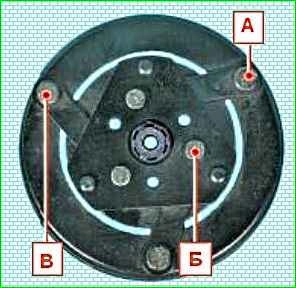
Inspect the riveted joints "A" and "B", as well as the elastic steel leashes "B" of the plate.
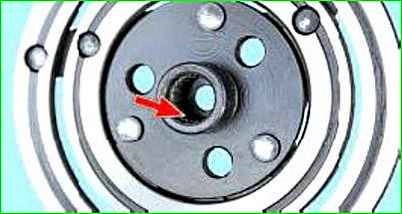
If the leashes are broken or the rivet joints are loose, replace the pressure plate.
Inspect the pressure plate splines. If the splines are worn, replace the plate.
Inspect the shaft seal surface
If there are signs of oil leakage through the shaft seal, the compressor must be replaced.
In some cases, if a leak is detected, the seal can be replaced.
But you need to know that the leak is caused by shaft play due to bearing wear or shaft wear in the seal area. It is better to replace the compressor immediately.

Using an expanding puller, remove the retaining ring of the pulley bearing
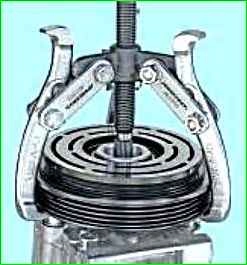
Installing the puller
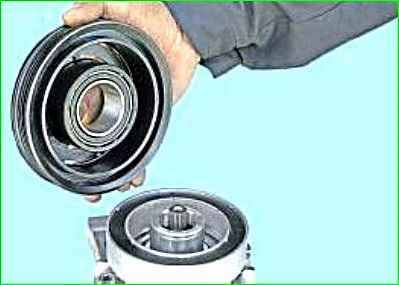
Press the pulley off the landing neck of the front cover of the compressor.
It is convenient to use a three-finger puller

After removing the pulley, inspect the splines 3 and threaded tip 2 of the shaft, groove 4 for the retaining ring and the seat surface 1 of the bearing journal (for clarity, the magnet coil is removed). If they are worn out or damaged, replace the compressor.

On a lathe, cut off the flaps to fix the bearing in the pulley
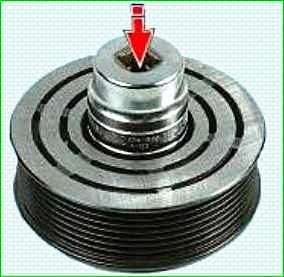
Using a mandrel of a suitable diameter, press out the old bearing from the pulley.
After removal, the bearing is no longer suitable, we replace it.
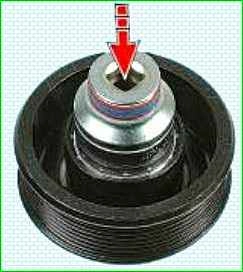
Press in the new bearing.

When pressing in, you need to be careful. The wall of the outer race of the pulley bearing is very thin. A slight tilt during pressing can lead to bearing failure.

After pressing, fix the bearing by punching the edge of the pulley mounting hole
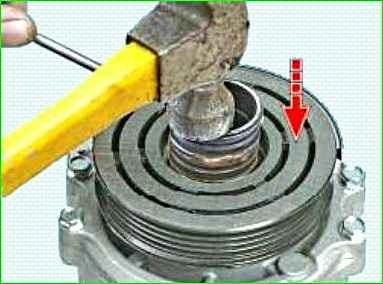
Press the pulley onto the front cover of the compressor. When pressing, apply force to the inner ring of the bearing.

Install the retaining ring
After pressing onto the compressor, check the condition of the pulley. It should rotate silently, without jamming, and evenly. There should be no axial or radial runout.
If axial or radial runout is detected during inspection, the pulley is replaced.
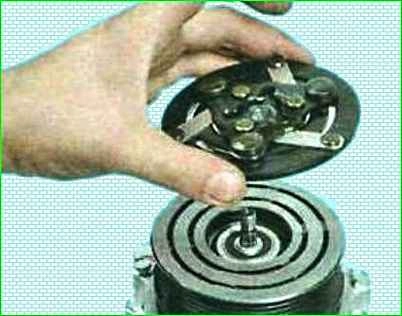
Press the pressure plate

Screw on the old fastening nut
The pressure plate can be installed on the shaft in only one position.
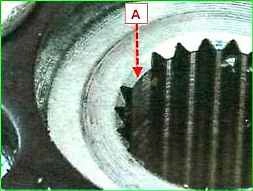
When installing, align the protrusion "A" on the inner splined surface of the plate and the recess on the outer splined surface of the shaft.
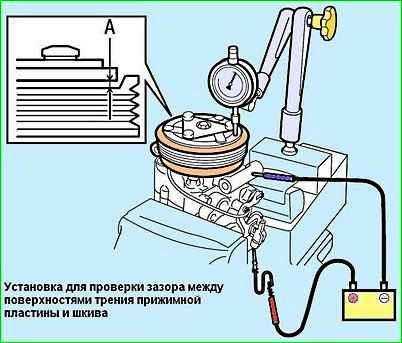
Install the compressor in a vice
Install the dial indicator.
Connect the positive terminal of the battery to the winding connector coils, negative terminal to the compressor body.
We measure the gap "A" between the friction surfaces at different points. If the gap is not the same, we replace the pressure plate. The nominal gap is (0.35±0.02) mm.
If the gap differs from the nominal size, remove the pressure plate.
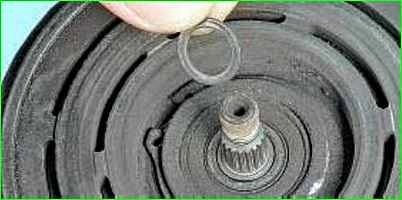
To adjust the gap, use special calibration washers.
After adjustment, unscrew the old bolt from the shaft end and screw in a new bolt.
Install the compressor and all removed parts.
Refilling the air conditioning system, article - Bleeding and filling the air conditioning system of a Lada Largus with refrigerant
Replacing the compressor clutch solenoid
Tools required for the job: a set of screwdrivers, an 18 key, pullers for removing the pulley, a puller for removing the solenoid and a tester
Removing the refrigerant from the system. Remove the compressor.
Remove the pressure plate
Remove the drive pulley as described above
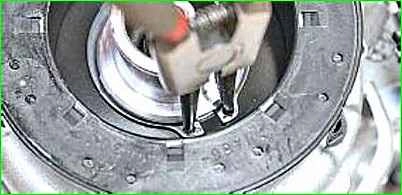
Remove the retaining ring of the compressor clutch solenoid
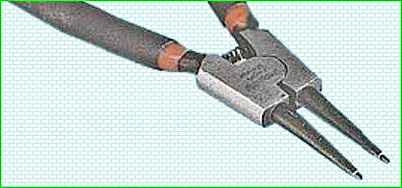
To remove the retaining ring, use a special expanding puller
Move the electromagnet from the landing belt of the front cover of the compressor and remove it
Check the resistance of the electromagnet coil winding and the absence of a short circuit to the housing with an ohmmeter. The resistance should be 3.6-3.8 Ohms.

We install the electromagnet on the front cover of the compressor.
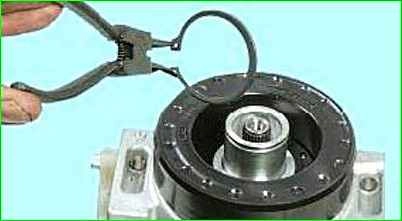
Make sure that the retaining ring is fully seated in the groove

When installing the coil on the compressor, the locking protrusion "A" on the rear surface of the coil housing must enter the recess "B" on the compressor cover.
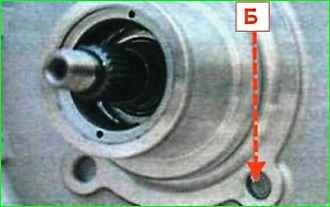
Press the pulley onto the landing neck of the front cover of the compressor. You need to apply force to the inner race of the bearing.
After pressing, check the rotation of the pulley.
Install the compressor and other parts in reverse order.
Fill the system with refrigerant.





